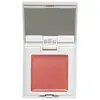What's inside
What's inside
 Key Ingredients
Key Ingredients

 Benefits
Benefits

 Concerns
Concerns

 Ingredients Side-by-side
Ingredients Side-by-side

Mica
Cosmetic ColorantSynthetic Fluorphlogopite
Magnesium Stearate
Cosmetic ColorantBoron Nitride
AbsorbentDimethicone
EmollientSilica
AbrasiveEthylhexyl Palmitate
EmollientCopernicia Cerifera Wax
Octyldodecyl Stearoyl Stearate
EmollientAluminum Hydroxide
EmollientPhenoxyethanol
PreservativeTocopheryl Acetate
AntioxidantCaprylyl Glycol
EmollientTriethoxycaprylylsilane
Simmondsia Chinensis Seed Oil
EmollientBambusa Arundinacea Juice
AbrasiveButyrospermum Parkii Butter
Skin ConditioningCI 77891
Cosmetic ColorantIron Oxides
CI 16035
Cosmetic ColorantCI 77742
Cosmetic ColorantMica, Synthetic Fluorphlogopite, Magnesium Stearate, Boron Nitride, Dimethicone, Silica, Ethylhexyl Palmitate, Copernicia Cerifera Wax, Octyldodecyl Stearoyl Stearate, Aluminum Hydroxide, Phenoxyethanol, Tocopheryl Acetate, Caprylyl Glycol, Triethoxycaprylylsilane, Simmondsia Chinensis Seed Oil, Bambusa Arundinacea Juice, Butyrospermum Parkii Butter, CI 77891, Iron Oxides, CI 16035, CI 77742
Ingredients Explained
These ingredients are found in both products.
Ingredients higher up in an ingredient list are typically present in a larger amount.
Ci 77891 is a white pigment from Titanium dioxide. It is naturally found in minerals such as rutile and ilmenite.
It's main function is to add a white color to cosmetics. It can also be mixed with other colors to create different shades.
Ci 77891 is commonly found in sunscreens due to its ability to block UV rays.
Learn more about CI 77891Phenoxyethanol is a preservative that has germicide, antimicrobial, and aromatic properties. Studies show that phenoxyethanol can prevent microbial growth. By itself, it has a scent that is similar to that of a rose.
It's often used in formulations along with Caprylyl Glycol to preserve the shelf life of products.
Silica, also known as silicon dioxide, is a naturally occurring mineral. It is used as a fine, spherical, and porous powder in cosmetics.
Though it has exfoliant properties, the function of silica varies depending on the product.
The unique structure of silica enhances the spreadability and adds smoothness, making it a great texture enhancer.
It is also used as an active carrier, emulsifier, and mattifier due to its ability to absorb excess oil.
In some products, tiny microneedles called spicules are made from silica or hydrolyzed sponge. When you rub them in, they lightly polish away dead skin layers and enhance the penetration of active ingredients.
Learn more about SilicaThis ingredient is a combination of red, black, and yellow iron oxide pigments. This combination of colors is usually found in foundation, because it results in a "skin" color.